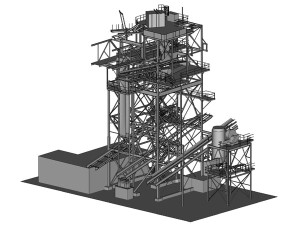 BIM or building information modeling is a classic symbolism of technology disrupting the traditional methods of construction and yielding outstanding results by the aid of technology.
BIM or building information modeling is a classic symbolism of technology disrupting the traditional methods of construction and yielding outstanding results by the aid of technology.
What is BIM?
BIM aids a construction project in designing, building, and operating a building using 3D models rather than a series of drawings. It enables engineers, designers, and construction managers, to simulate the structure and functionality of a construction structure with accuracy and devise systematic solutions to create a risk, free, highly functional facility.
Why Use BIM?
Here are some reasons to replace traditional methods with BIM in building construction.
Easy Exchange of Information
Earlier, the traditional methods of design and construction required stakeholders and creators to deal with a lot of paperwork. The communication workflow relied heavily on multiple file-formats scattered across devices, people, and formats which made it difficult for the stakeholders to maintain transparency in the process. It was easy to miss out on certain details and for parties to fall out of sync in communication.
With BIM, all the details of the construction project are stores as a single unit of information. Inbuilt tools enable designers and constructors to share information with various stakeholders in a click, thereby, maintaining consistency in the process and ensuring that everyone is on the same page.
Greater Efficiency
“Fail fast” has become famous in recent years. It refers to the experimenting with trying new things, and if an idea fails, quickly reiterating the process by learning from mistakes and moving along. This is hardly a feasible option in the world of construction when so much: time, money, materials, environmental commitments, and public and government commitments are at stake. In the world of construction, the bottom line is more like do it once and do it right.
Thankfully with BIM, all the information, right from the idea conception to the blueprint layout and final decisions are digitally imagined and stored in a single repository. BIM also makes it easy to test the functional capabilities of construction, thereby allowing engineers to simulate testing conditions with greater accuracy and use the findings to build a sturdy construction that lasts. All this leads to judicious use of resources invested, helps the team in adhering to the timelines, and results in greater efficiency for the project.
Accurate Sustainability Analysis
One of the evaluations engineers carry out in the pre-construction or early stages of construction is a sustainability check of the building. This includes assessing the building’s future performances, constructability, and performance. BIM software has inbuilt methods to test the building by simulating its exposition to energy, acoustics, load, and lighting. The results from this simulation are reliable and nearly accurate and have a major impact on the construction timeline and the final result.
Flexibility
Since BIM can easily experiment with design and other factors and data can be tweaked without affecting the actual building construction, using the software provides great flexibility in design to the engineers. This flexibility allows them to consider alternates and devise multiple scenarios of the construction phase. Thus, they can easily weigh their options to study the costs and consequences involved in various options beforehand and can devise the best possible outcome using the software, a feat otherwise impossible or demanding a lot of work with the traditional methods.
Reduced Costs
Many stakeholders shy away from BIM because of their higher initial costs. But there are demonstrations in the construction world to show that BIM actually reduces the total cost of construction in the long run. A decrease in iterations, low wastage, a decrease in delays, and accurate communication are some of the factors that save a lot of project cost, in the long run, thanks to BIM.
During the actual construction itself, accurate design simulations in the previous stages help to achieve milestones more accurately and with greater efficiency. This leads to an avoidance of rework which saves a lot of time and helps the project to meet deadlines with ease.
Greater Insights into Project Life Cycle and its Data
Since BIM creates a central repository of data and lets the engineers carry out all kinds of simulation activities, the data collected along the way of the actual construction proves valuable in the post-construction stages too. All the data related to the requirement gathering, the design, the risk assessment, the construction, and its maintenance can be used for facility management to provide great post-construction support.
Such data can also be used to answer building queries quickly raised post-construction.
Conclusion
A lot of high-end building projects across the world having high stakes involved are already using BIM to change the way a construction project proceeds. BIM is more of an investment that you make in the initial stages that pay off more than the investment worth in the long run.
Reach out to us HERE today for more in-depth project information. We look forward to working with you!








